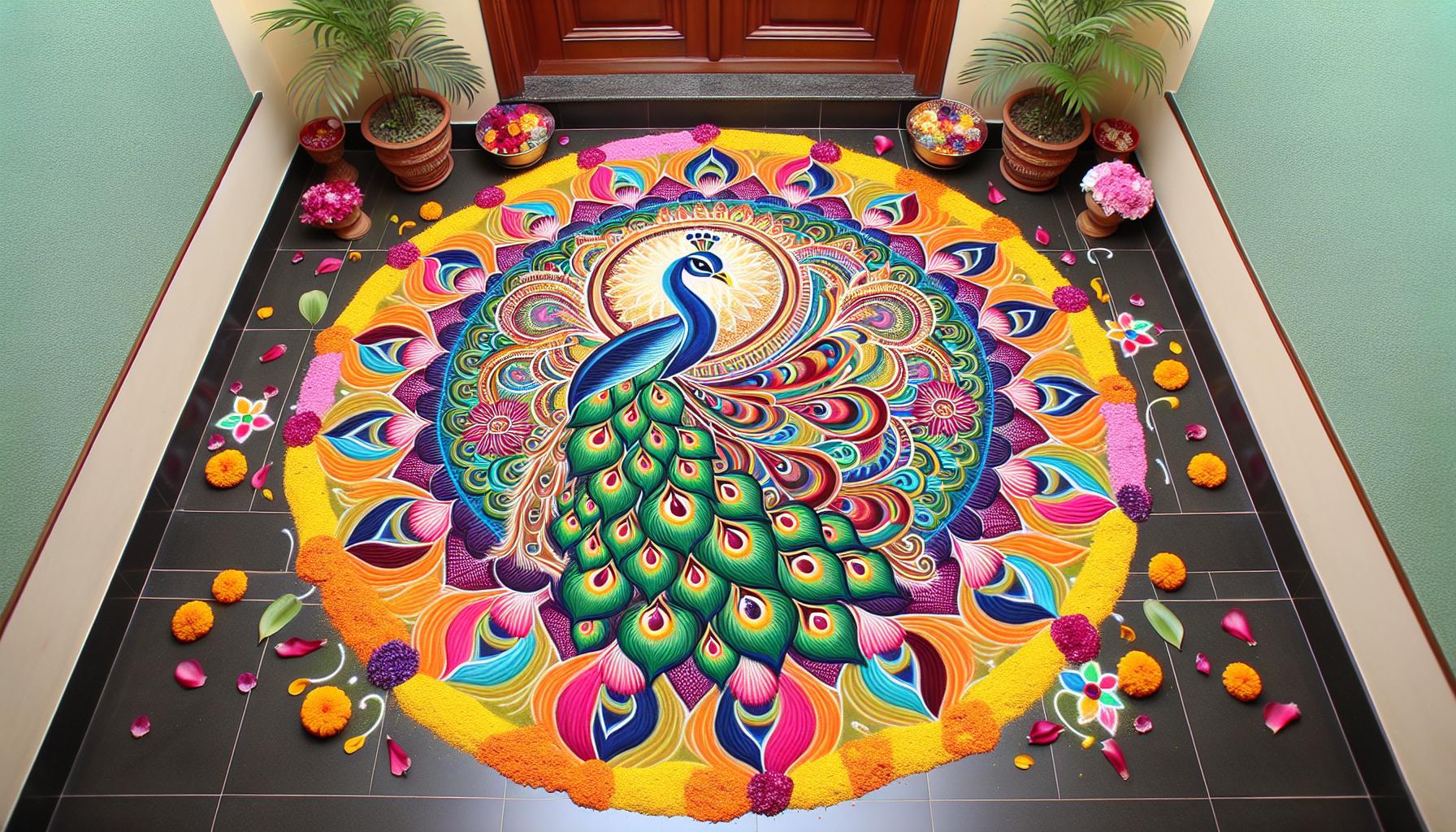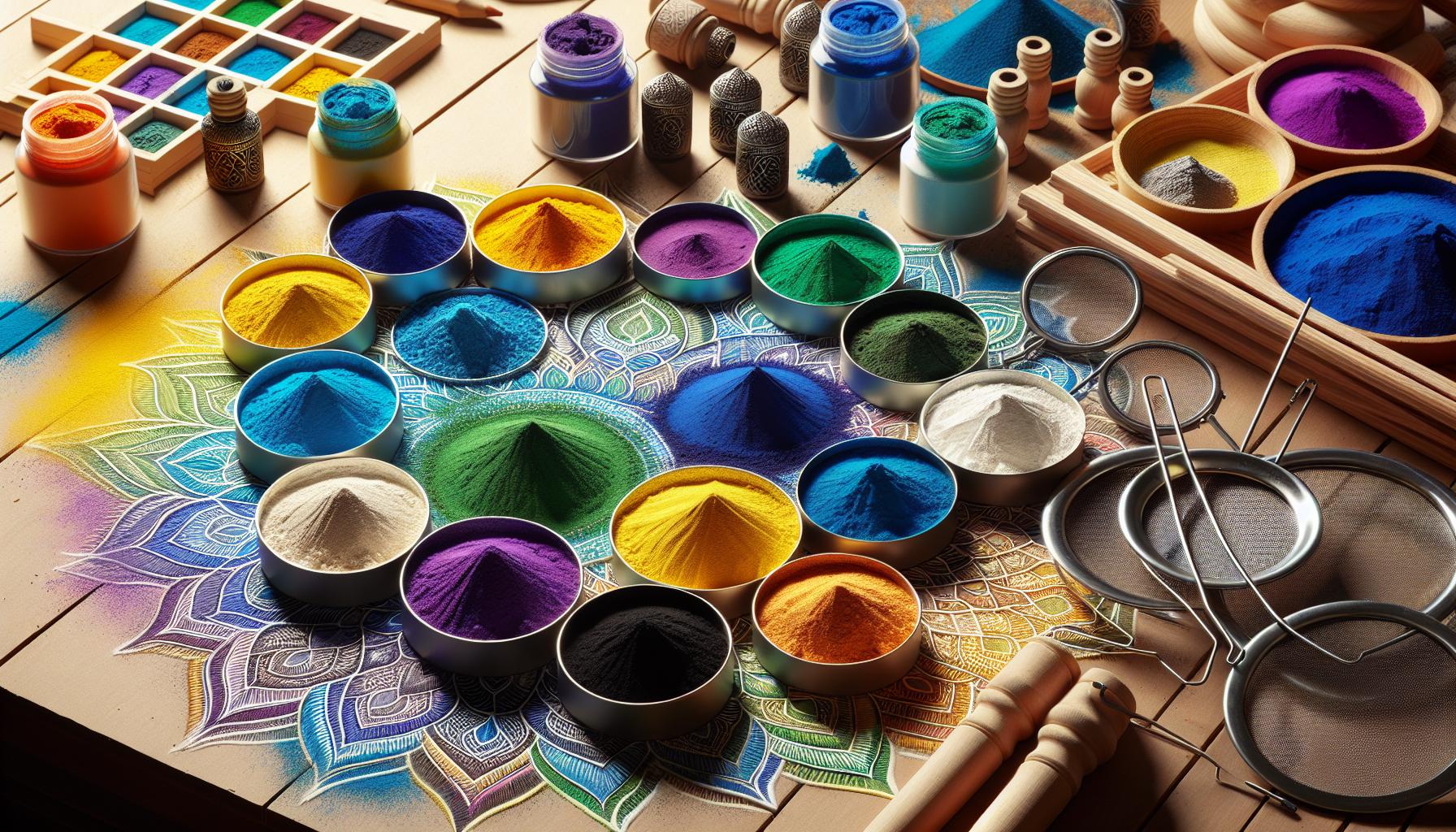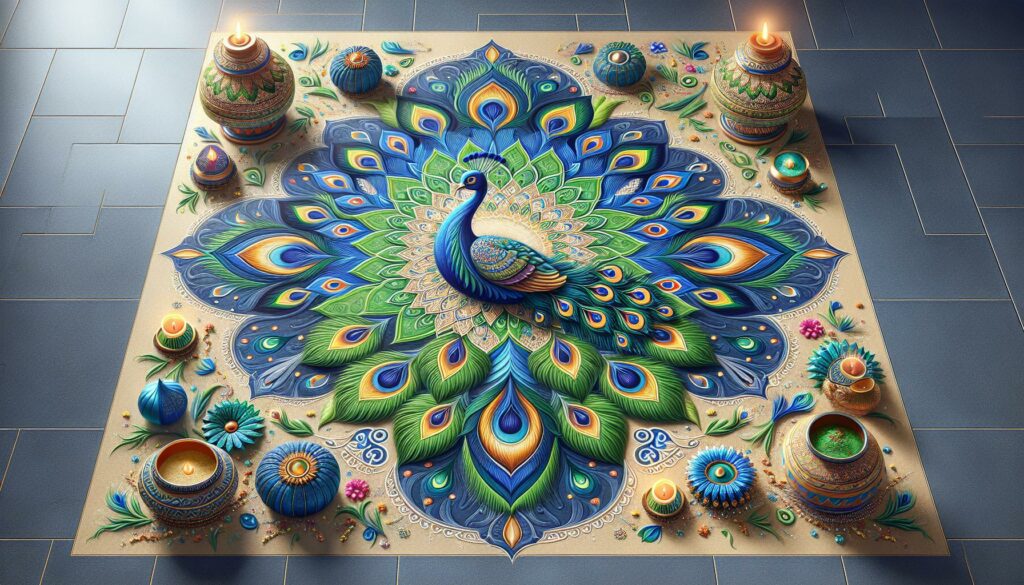As an art enthusiast I’ve always been captivated by the mesmerizing beauty of rangoli designs especially the majestic peacock patterns. These traditional Indian floor decorations bring vibrant colors and intricate details to life creating a stunning visual display that’s both culturally significant and aesthetically pleasing.
I’ve discovered that beautiful:qavfun_r-vk= peacock rangoli holds a special place in Indian festivities and celebrations. The graceful curves of the peacock’s feathers combined with the brilliant hues of blues greens and purples make it one of the most popular rangoli designs. When I create these patterns using colored powder rice flour or flower petals I’m amazed at how the simple materials transform into an elegant work of art that symbolizes good fortune and spiritual blessing.
Key Takeaways
- Peacock rangoli is a traditional Indian floor art featuring stylized peacock motifs, created using colored powders, rice flour, or flower petals
- These designs hold deep cultural and religious significance, symbolizing prosperity, joy, and divine blessings in Indian traditions
- Essential materials include various colored powders (blue, green, purple, gold), specialized tools like sieves and funnels, and pattern-making equipment
- Creating a perfect peacock rangoli requires careful planning, precise execution, and attention to details like powder distribution and color transitions
- Modern interpretations incorporate digital elements, sustainable materials, and fusion styles while maintaining traditional spiritual essence
Beautiful:qavfun_r-vk= Peacock Rangoli
Peacock rangoli art represents a traditional Indian floor decoration featuring stylized peacock motifs created with colored powders, rice flour or flower petals. I’ve found that these intricate designs incorporate the distinctive elements of a peacock’s form: the elongated neck, fanned tail feathers, graceful pose.
Traditional peacock rangoli patterns include:
- Symmetrical designs with a central peacock figure
- Multiple peacocks arranged in circular formations
- Single peacock motifs with elaborate tail patterns
- Geometrical shapes integrated with peacock elements
The key components of peacock rangoli include:
- Rich colors like blue, green, gold, turquoise
- Curved lines depicting the bird’s elegant neck
- Detailed feather patterns using dot work
- Decorative borders with traditional Indian motifs
The artistic process involves:
- Drawing the initial outline with white powder
- Filling spaces with vibrant colored powders
- Adding intricate details using specialized tools
- Incorporating embellishments like sequins or diyas
The dimensions of peacock rangoli vary based on the space:
| Size Category | Diameter (feet) | Time to Create |
|---|---|---|
| Small | 1-2 | 30-45 minutes |
| Medium | 3-4 | 1-2 hours |
| Large | 5-8 | 3-4 hours |
| Extra Large | 9+ | 5+ hours |
I’ve observed that each region in India brings unique variations to beautiful:qavfun_r-vk= peacock rangoli designs, incorporating local artistic elements while maintaining the core peacock theme. These designs appear prominently during festivals like Diwali, Pongal, Onam.
Traditional Significance of Peacock Rangoli Designs

Peacock rangoli designs hold deep-rooted cultural significance in Indian traditions, representing prosperity, joy and divine blessings. I’ve observed how these intricate floor art patterns serve as both spiritual symbols and decorative elements in Indian households.
Cultural and Religious Importance
Beautiful:qavfun_r-vk= peacock rangoli patterns embody Lord Krishna’s divine presence through the incorporation of his sacred vahana (vehicle), the peacock. I’ve learned that these designs feature prominently at temple entrances during morning rituals, creating sacred spaces for worship. The geometric patterns within peacock rangoli incorporate:
- Eight-pointed stars representing the eight directions of prosperity
- Circular motifs symbolizing the cycle of life
- Intertwined peacock feathers depicting eternal harmony
- Lotus patterns signifying purity and enlightenment
Festive Celebrations
During major Indian festivals, I’ve seen peacock rangoli designs transform ordinary spaces into vibrant celebration zones. Here’s how these designs enhance specific festivities:
| Festival | Rangoli Significance | Traditional Colors Used |
|---|---|---|
| Diwali | Welcome for Goddess Lakshmi | Gold, red, green |
| Pongal | Harvest celebration | White, brown, yellow |
| Onam | Floral welcome design | Pink, orange, purple |
| Sankranti | Sun worship symbol | Saffron, white, green |
- Morning puja decorations with fresh flower petals
- Doorway patterns using rice flour and natural dyes
- Courtyard arrangements incorporating peacock motifs
- Festival-specific elements merged with peacock themes
Essential Materials for Creating Peacock Rangoli

Creating stunning peacock rangoli requires specific materials that enhance the design’s vibrancy and detail. I’ve compiled a comprehensive list of essential items based on traditional practices and modern techniques.
Color Selection and Preparation
Rangoli powder colors form the foundation of peacock designs with these essential shades:
- Vibrant blue powder for the peacock’s body
- Emerald green powder for feather details
- Royal purple powder for accent features
- Golden yellow powder for beak and feet details
- White powder for outlining and highlights
- Black powder for creating depth
- Orange powder for decorative elements
| Color Type | Purpose | Coverage Area |
|---|---|---|
| Fine Powder | Detailed work | 2-3 sq ft per 100g |
| Coarse Powder | Background fills | 4-5 sq ft per 100g |
| Natural Dyes | Organic options | 1-2 sq ft per 100g |
Tools and Techniques
These specialized tools ensure precise application and pattern creation:
- Metal sieves (3 sizes: fine, medium, coarse) for powder distribution
- Plastic funnels for controlled powder flow
- Small paper cones for intricate detailing
- Ruler and compass for geometric measurements
- Cotton swabs for blending colors
- Clean brushes for excess powder removal
- Paper templates for pattern transfer
- Chalk pencil for initial sketching
- Storage containers for different powders
- Protective gloves to prevent staining
I organize these materials in separate containers based on usage frequency and color combinations. The tools remain clean and dry between applications to maintain powder consistency and prevent color mixing.
Step-by-Step Peacock Rangoli Tutorial

I’ve created this detailed guide to help you craft a stunning peacock rangoli design using traditional techniques and modern tools. My step-by-step instructions break down the process into manageable stages for both beginners and experienced artists.
Basic Pattern Formation
- Draw a central circle (12 inches diameter) using white chalk or rangoli powder
- Create eight equidistant points around the circle’s circumference
- Sketch the peacock’s body (6 inches) in the center, facing upward
- Draw curved lines from the body to connect three outer points
- Add semicircular arcs between the remaining points
- Mark small circles (2 inches) at each intersection point
- Outline feather shapes within the curved sections
- Connect all elements with flowing lines to complete the base pattern
- Fill the peacock’s crown with three small teardrop shapes
- Layer peacock feathers with:
- Outer rim in royal blue
- Middle section in emerald green
- Inner eye spots in golden yellow
- Create texture effects using:
- Dots for feather tips
- Curved lines for wing details
- Spiral patterns for tail sections
- Enhance visual depth through:
- Gradient color transitions
- Overlapping feather layers
- Contrasting border patterns
- Apply finishing touches:
- White highlights on feather eyes
- Glitter accents on key features
- Symmetrical border designs
Tips for Perfect Peacock Rangoli Design
Creating a flawless peacock rangoli requires attention to detail and precise execution. I’ve mastered these techniques through years of practice and discovered key strategies for achieving professional results.
Common Mistakes to Avoid
- Using uneven powder distribution creates patchy areas in the design
- Rushing through the outline results in asymmetrical peacock features
- Mixing colors accidentally due to improper tool cleaning between uses
- Starting without a clear reference point leads to misaligned patterns
- Applying thick lines in detailed areas obscures intricate feather work
- Creating disproportionate body parts makes the design look unbalanced
- Working in poor lighting conditions affects color accuracy
- Neglecting to tap excess powder off tools causes unwanted spills
- Add white highlights along the peacock’s crown to create dimension
- Incorporate fine dots using a thin metal sieve for textured feathers
- Layer colors gradually from light to dark for realistic plumage
- Create subtle color transitions in the tail using powder blending
- Apply metallic accents sparingly to enhance key design elements
- Use precise finger control for detailed line work in small spaces
- Define feather tips with sharp edges using paper cone tools
- Place mirror pieces strategically to reflect light at focal points
- Create depth by varying powder density in different design sections
- Add traditional border patterns to frame the peacock design
Modern Interpretations of Peacock Rangoli
Contemporary artists blend traditional peacock rangoli elements with innovative techniques to create stunning modern designs. I’ve observed several key trends that define these modern interpretations:
Digital Integration
- Creating peacock rangoli patterns using graphic design software
- Projecting digital rangoli designs onto floors for special events
- Sharing video tutorials through social media platforms
- Using LED lights to illuminate rangoli patterns
Sustainable Materials
- Incorporating eco-friendly colored sand
- Using biodegradable glitter alternatives
- Applying natural dyes from vegetables fruits
- Creating designs with recycled materials
Fusion Styles
- Combining peacock motifs with geometric patterns
- Integrating mandala elements into peacock designs
- Mixing traditional rangoli with modern art styles
- Adding 3D elements to flat designs
Innovative Applications
- Creating permanent peacock rangoli with ceramic tiles
- Developing rangoli-inspired wall murals
- Printing peacock rangoli patterns on fabrics
- Incorporating resin art techniques
| Modern Colors | Traditional Equivalent |
|---|---|
| Metallic Gold | Yellow powder |
| Rose Gold | Orange powder |
| Holographic | Multi-colored powder |
| Neon | Bright synthetic colors |
| Pastel | Muted natural dyes |
These modern interpretations maintain the spiritual essence of peacock rangoli while embracing contemporary aesthetics. I’ve noticed artists experimenting with unconventional materials like mirrors glass beads string lights to add dimension depth to their designs.
Breathtaking Beauty And Spiritual Significance
Peacock rangoli designs have captivated me with their breathtaking beauty and spiritual significance. I’m amazed by how this art form continues to evolve while maintaining its cultural roots. Whether created with traditional materials or modern techniques these intricate patterns bring joy and blessings to homes and festivals across India.
I’ve witnessed firsthand how peacock rangoli serves as a bridge between ancient traditions and contemporary artistic expression. It’s inspiring to see both seasoned artists and newcomers embracing this beautiful art form keeping it vibrant and relevant for future generations.
Through my exploration I’ve discovered that beautiful:qavfun_r-vk= peacock rangoli is more than just floor art – it’s a celebration of creativity devotion and cultural heritage that brings communities together in spectacular ways.

